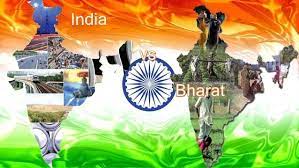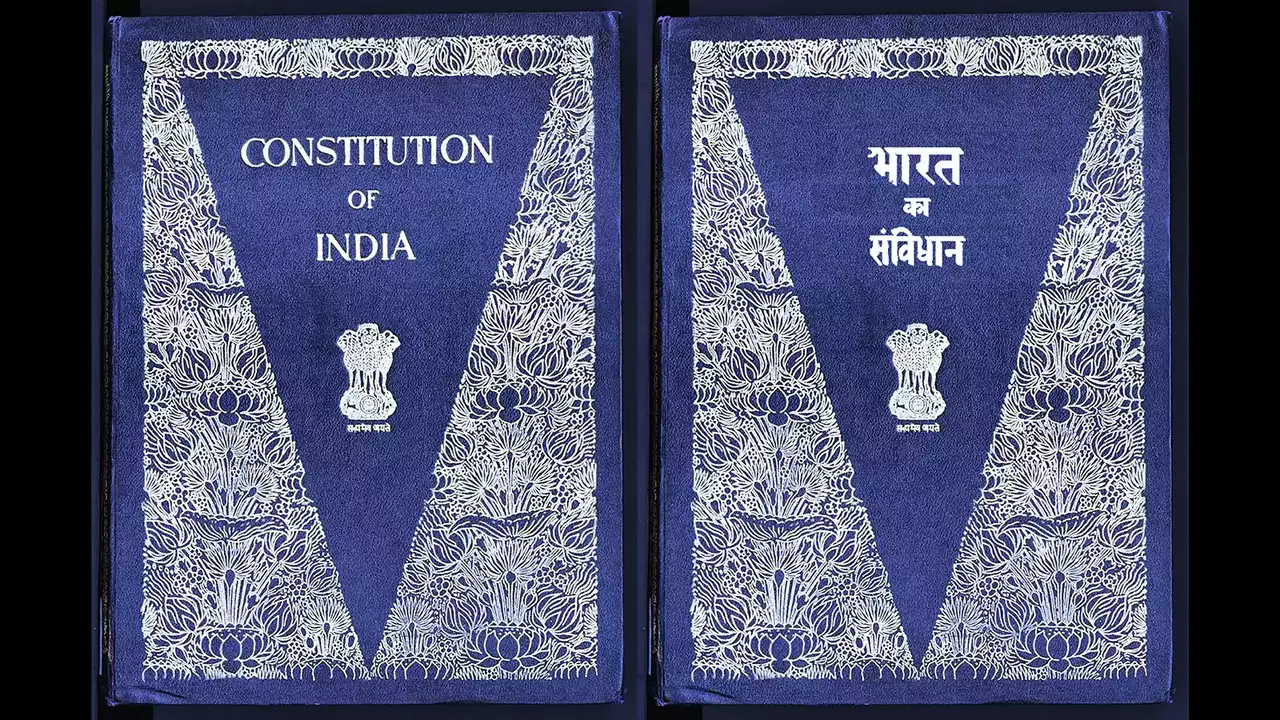As “India, that is Bharat” plunges into a frenzied if largely risible political jockeying over the country’s nomenclature, reading the debates of the Constituent Assembly dating back to December 9, 1946, reveals a sober and civilized parliamentary discussion on the subject.
A sampling of comments in the Constituent Assembly debates shows none of the current angst over the name triggered by the speculations that Prime Minister Narendra Modi’s government is about to rename India as Bharat. The incongruity of “India, that is Bharat”, as given by Dr. Bhimrao Ambedkar, who drafted the Constitution, was pointed out by some members of the Constituent Assembly just as an independent India was taking shape.
The incongruity of “India, that is Bharat”, as given by Dr. Bhimrao Ambedkar, who drafted the Constitution, was pointed out by some members of the Constituent Assembly just as an independent India was taking shape.
Addressing the Assembly. Dr. Ambedkar said, “I propose to move amendment No. 130 and incorporate in my amendment No. 197 which makes a little verbal change in sub-clause (2). I move “That for clauses (1) and (2) of article 1, the following clauses be substituted: India, that is, Bharat, shall be a Union of States.”
Blending of East and West’
 Mohammed Tahir, a member from Bihar, said, “I would like to submit that it is a matter of shame that our Constitution could not fix a name for our country. This is a proof of the intelligence of Dr. Ambedkar that he suggested a hotch-potch sort of name and got it accepted. Well, if somebody would have asked Doctor Saheb about his homeland, he could have replied with pride that he belonged to Bharat or India or Hindustan. But now the Honourable Dr. will have to reply in these words: “I belong to India that is Bharat”. Now, Sir, it is for you to see what a beautiful reply it is.” Tahir’s comments came during a debate on November 24, 1949.
Mohammed Tahir, a member from Bihar, said, “I would like to submit that it is a matter of shame that our Constitution could not fix a name for our country. This is a proof of the intelligence of Dr. Ambedkar that he suggested a hotch-potch sort of name and got it accepted. Well, if somebody would have asked Doctor Saheb about his homeland, he could have replied with pride that he belonged to Bharat or India or Hindustan. But now the Honourable Dr. will have to reply in these words: “I belong to India that is Bharat”. Now, Sir, it is for you to see what a beautiful reply it is.” Tahir’s comments came during a debate on November 24, 1949.
Algu Raj Shastri, a member from the United Provinces, said this on November 21, 1949, “It is, Sir, a matter of deep sorrow and deep regret for me that we in this country did not rise above the slave mentality and we did not say frankly what would be the name of our country. I think, Sir, there is no single country of the world which has such a clumsy name as we have given to our land that is ‘India, that is Bharat.’ The fact, Sir, is it is no name at all and we have failed very badly in giving it a proper name.”

Pandit Thakur Das Bhargava, a member from East Punjab took a more nuanced position on November 18, 1949, saying, “Now I would like to draw your attention, Sir, to a few minor things embodied in the Constitution. India has, no doubt, recovered herself; we have got our ancient India now. As regards the name of the country the term India that is Bharat” has been laid down in the Constitution and some of my friends objected to this term. As for me, I have no serious objection to it. It is a fact that we cannot live in isolation from the rest of the world; We have centuries-old connections with England and the rest of the world. The world will always know us by the name of India. But so far as we are concerned, in our hearts and souls our country shall always remain as Bharat. So the terms India and Bharat have been bracketed in order to meet the needs of our countrymen as well as of the outsiders. The world will call us as India and we ourselves will call us as Bharat. Thus there will be blending of the East and the West.”
Divergent opinions
Hari Vishnu Kamath, a member from Central Provinces and Berar, put a much finer point on the debate on November 14, 1949. “The Draft as passed by the House reads, “India, that is, Bharat”. The revised draft presented to the House says, “India, that is Bharat”. That I do not think is what was intended by the House when we accepted article 1. What was meant was, India, that is to say, Bharat. That is why two commas were inserted and the phrase was interposed. It does not mean, “India, that is Bharat,”. This is wrong English, so far as the meaning intended is concerned. I think the original was perfectly correct and it was absolutely wrong on the part of the Drafting Committee to change the wording.”
In another debate he also said, “Some ascribe it (name of Bharat) to the son of Dushyant and Shakuntala who was also known as “Sarvadamana” or all conqueror and who established his suzerainty and kingdom in this ancient land. After him this land came to be known as Bharat. Another school of research scholars hold that Bharat dates back to Vedic…”
That seemed to test Ambedkar’s patience. “Is it necessary to trace all this? I do not understand the purpose of it. It may be well interesting in some other place. My friend accepts the word “Bharat”. The only thing is that he has got an alternative. I am very sorry but there ought to be some sense of proportion, in view of the limited time before the House,” he said.
Jagat Narain Lal, a member from Bihar, had a different spin altogether. “I come to some of the drawbacks, or, I might say, some of those omissions which I regret. For example, Sir, I would have liked the name ‘Bharat’ to come before India. It is a fact that ‘Bharat’ and India have come in, but I would have liked ‘Bharat’ to come before India, he said on November 25, 1949.
R K Sidhva, a member from the Central Provinces and Berar, was both prescient and reasonable in saying on November 25, 1949, “India in future will be called Bharat but that does not mean that we discard the name Hindustan.”
Kamalapati Tripathi, a member from the United Provinces, said, “We are pleased to see that this word has been used and we congratulate Dr. Ambedkar on it. It would have been very proper, if he had accepted the amendment moved by Shri Kamath, which states “Bharat as is known in English language ‘India’”.
Change in debating nature
To which Ambedkar responded saying, “This matter was debated at great length last time. When this article came before the House, it was kept back practically at the end of a very long debate because at that time it was not possible to come to a decision as to whether the word “Bharat” should be used after the word “India” or some other word, but the whole of the article including the term “Union”—if I remember correctly— was debated at great length. We are merely now discussing whether the word “Bharat” should come after “India”. The rest of the substantive part of the article has been debated at great length.”
Several other members had also chimed in during the historic debates. Seth Govind Das, also from the Central Provinces and Berar, said on November 17, 1949, “In this Constitution, our country has been named ‘India that is Bharat’. It is a matter of gratification that the name Bharat has been adopted, but the way in which this has been put there has not given us full satisfaction. ‘India that is Bharat’ is a strange name.”
Lakshminarayan Sahu, from Orissa, said on 17 November 1949, “Our country was first named Bharat. Then it was thought that ‘Bharat’ would not be understood by other countries of the world and the words ‘India that is Bharat’ were included. What is this?”
A.B. Mandloi of the Central Provinces and Berar, said on November 18, 1949, “Taking into account our ancient civilisation, culture and traditions, we have adopted a suitable name for our country, namely, Bharat. That has also been done with the common consent of all.”
“It fills our heart with joy when we consider that once more this ancient land which was hitherto known as India only will be known as Bharat,” said Rohini Kumar Chaudhuri, of Assam, on November 22, 1949. “For the first time, after a dependence of more than 1,000 years India, Bharat has emerged as a Sovereign Democratic Republic,” said S. V. Krishnamoorthy Rao of Mysore State the same day.
The overall tone of the debates over the name of the country as incorporated in the new constitution was reasonable even though at times very detail-oriented. Dr. Ambedkar did seem to occasionally display impatience over the way some of the members dwelt on the country’s ancient past to make their points.
From there to now, there has been a remarkable change in the way the same subject is being discussed with the politics of its timing as well as its hidden motivation, namely, to thwart the newly minted INDIA opposition alliance, dominating the discourse. (The author is a Chicago-based journalist, author, filmmaker and commentator. Views are personal. By special arrangement with Indica) Read more at:
